Centennial past time for 2nd royal commission on forestry
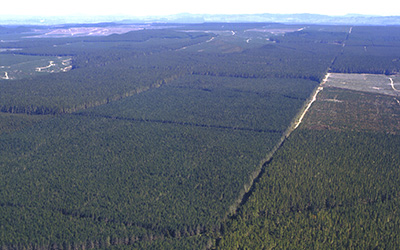
Originally written for, and published in, the
August 2012 edition of Indigena, the quarterly
journal of the Indigenous Forest Section of the
New Zealand Farm Forestry Association
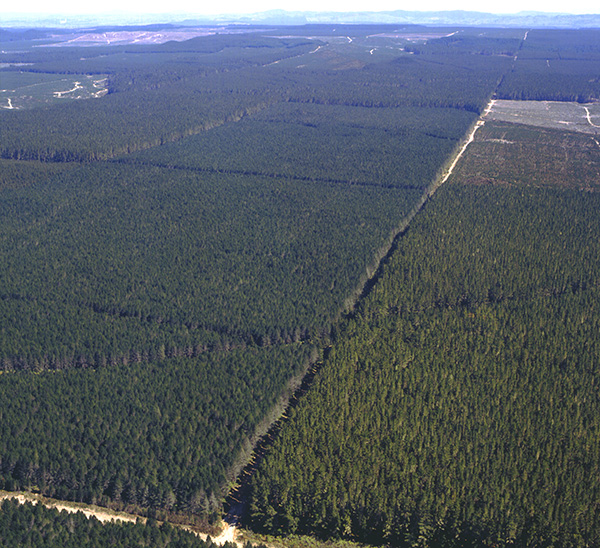
Top Carbon Competition: Radiata pine forests are unassailable in their raw capability for drawing down carbon dioxide, which just means that to compete proponents of indigenous forestry will have to become fiendishly inventive and monstrously more efficient. photographer Jonathan Barran
There’s a strong argument for planting mostly radiata pine.
Drawing down carbon dioxide at double the rate of kānuka and mānuka, radiata pine grows seven times faster in Aotearoa than in its Californian home range. And 160 years after its introduction, from breeding to nursery to extraction to market, radiata pine forestry is a highly evolved industry.
But as crucial as it is, there is more than carbon sequestration to be considered. Radiata pine is typically harvested after 28 years when, in an ideal world, the bulk of the material would be put to uses that continue to sequester the carbon long term. And if this very versatile timber replaces cement, steel, aluminium and plastic—some types of plastic, weight for weight, generate six and a half times more carbon dioxide than does cement during manufacture—the benefit is much multiplied.
Nevertheless, because the performance of radiata pine is proven and the infrastructure is in place, is insufficient reason for failing to vigorously explore an expanded role for indigenous forestry. But before embarking on that exploration, the competing global need for food production must first be acknowledged. Despite the Green Revolution, nearly a billion of the Earth’s seven suffer chronic hunger. With less than 10% of the Earth’s surface suitable for agriculture, and about 20% of that in the zone less than 10 metres above sea level, and with population poised to possibly more than double, sacrificing arable land to non– food producing uses is becoming increasingly difficult to justify.
Setting aside the systemic failure of the world’s financial systems, which can probably only be remedied through nationalisation—temporarily or otherwise—three unprecedentedly disruptive global crises are unfolding. They are, in order of cruciality, and arguably criticality, runaway global warming, population growth and peaking oil production. Only in hindsight will it be known whether global warming had already become unstoppable by 2012. Some climate scientists are more sanguine than others in this regard but many privately admit to being gravely concerned that decades of inaction have already given global warming feedbacks a free hand. Because the consequences for humanity and its fellow species of runaway global warming are so unspeakably dire, immediate climate action mobilisation is the only rational response.
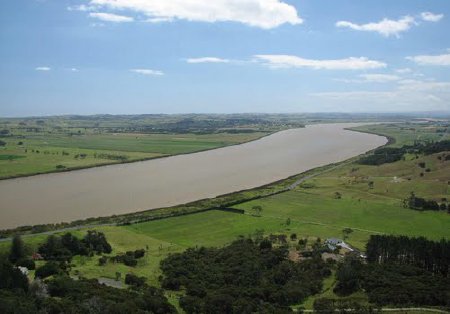
Fertile Flats First to Go: Even the lowest of sea-level rise projections will see the inundation of significant areas of arable land, such as these Wairoa River plains, this century. Less than 10% of the Earth’s surface is suitable for agriculture, and about 20% of that in the zone less than 10 metres above sea level. image NZ Frenzy Guidebook
Despite the writings of towering figures from Aristotle, to Dr Martin Luther King, Jr., to Sir David Attenborough, population growth remains an emotionally charged subject and taboo in almost all forums, including those most exercised by its impact—those concerned by the cruel human impact of global warming. But while the benefit of sooner rather than later returning human population to nearer its long-term sustainable level—which is closer to 2.7 than to the present 7.02 billion—is manifest, rapid action to achieve this is seemingly even less likely than that required to scale back fossil fuel use.
The particular significance of oil in this context is that its concentrated energy is the primary source of global economic wealth. But with the low-hanging fruit now picked, the world’s utter dependency on this highly concentrated energy, almost free of charge, is about to place severe financial restraints on almost every human activity. Discretionary spending on many virtuous projects, including indigenous forestry, is set compete with the crucial and the critical, not least of all spending on global warming mobilisation. It is deeply ironic that, had oil production had the decency to peak a century ago before greenhouse gases seriously began to threaten a stable climate, humanity may never have become so hopelessly hooked on its high-energy lifestyle.
All this is by way of saying that when it comes to establishing indigenous plants, whether for amenity, production or restoration purposes, the imperatives of food production, carbon dioxide sequestration and fossil fuel substitution will often deserve priority. And another way of saying this, is that climate action demands that indigenous forestry and planting be stringently prioritised to land most suited for it, and least suited to food production and exotic forestry. Examples of poor optimisation are not hard to find and include one of the trial sites involved in the open-ground indigenous plant establishment trial blocks, where the planting occurred under the former Rodney District Council’s subdivision rules. Two hectares, of an admittedly considerably larger area planted, consist of river terrace potentially suited to cropping, while streams and seeps on the same property remain unfenced and unplanted.
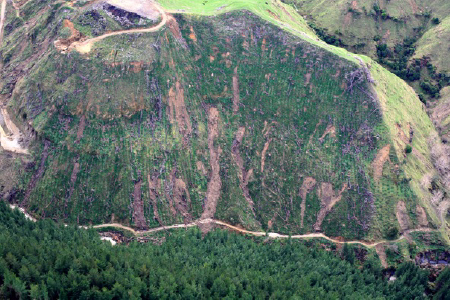
Uphill Battle: Just when billions of more trees need to be planted in Aotearoa, the extra carbon dioxide they required to address has increased atmospheric water vapour, making storms measurably more destructive, consistent with the wind-thrown radiata pine seen here. And while indigenous species are potentially more suited to terrain such as this seriously erosion-prone East Coast hill country, at current prices they can be 30 times more expensive to establish than radiata pine. image New Zealand Farm Forestry Association
Commencing with the unequivocal
Commencing with land where the case for indigenous restoration planting unequivocal: The immediate riparian margins. For a raft of obvious reasons, stream and coastal margins are priority areas for undisturbed indigenous vegetation. However, where low-impact access is available, extraction should remain an option. For example, rather than allow a destabilised riverbank tōtara to capsize in its own time, it might less disruptively be felled into the watercourse, or extracted from an adjoining paddock.
It might seem that large-scale indigenous restoration or forestry planting would struggle to become established under a climate action oriented land use regime, but this does not necessarily follow. Not only are there considerable areas where accessibility, terrain and soil type makes land unsuited for food production or forestry, many areas would potentially qualify through amenity, cultural, recreational and biodiversity factors, and combinations of these factors.
In respect to biodiversity, for example, the creation of ecological corridors presents a prime opportunity for restoration planting. But nor should combinations of restoration planting and indigenous forestry be overlooked.
Pockets of pasture
When radiata pine was introduced to the landscape of Aotearoa in the 1850s, it was for amenity purposes and as wind breaks. Here indigenous species should be the default option—it is instructive, in several respects, that this was one of the first uses to which radiata pine was put. Tōtara, unbidden, have been attempting this on their own, sometimes finding that they become the living fence posts. Aside from the potential of perfecting purpose-grown live tōtara fence lines, there is also opportunity to re-visualise the rural landscape. Had cost-effective means existed for European settlers to carve out pockets of pasture from the indigenous forest, the landscape of Aotearoa might have retained considerably more of its biodiversity and aesthetic value, and retained more of its relatively scant reserves topsoil. Instead, a good hot burn was key to sufficiently clearing the forest to enable grazing and cropping to be got underway. The sprinkling of pōhutukawa and pūriri that characterise the Mahurangi Harbour’s contemporary landscape is testimony to the resistance the tough and durable timber of these trees presented to the settlers’ cross cut saws. Conceivably, total productivity of many farms could be increased, even in the relatively short term, were paddocks radically redefined and redrawn to optimise a balance of sustainable pasture with indigenous forestry, and restoration planting.
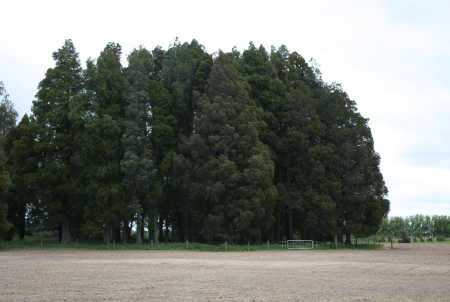
Sacrosanct Monoculture: A more imaginative mix of restoration, biodiversity enhancement, and production forestry has the potential to improve outcomes for birds and bees, and for the farmers largely expected to fund the conservation of pockets of indigenous forest, such as this Hauraki Plains kahikatea re-growth. photographer Michael Bergin
Pocket forests
But there are also smart–green opportunities when addressing a more common opportunity is presented: Where pockets of forest survive, amidst pasture. While the visual amenity of isolated stands of kahikatea is immense, biodiversity values are typically very low. What is not immediately obvious to most is that rather than being remnants of indigenous forest, these iconic stands are invariably regrowth that owes its existence to the boggy nature of the immediate ground the monoculture has colonised. So rather than take the usual hard-line conservationist position of treating everything within the pocket as sacrosanct, a partially exploitive approach might maximise land use values, particularly that of biodiversity. First the stand might be thinned, removing millable specimens and sufficient other stems to allow the balance to reach their potential mass. After a temporary electric fence is erected using material from the thinning process at the perimeter of an area possibly twice that of the original stand, a live tōtara ‘fence posts’ could planted immediately inside the temporary posts, which would subsequently support the permanent fence, featuring hot wires. The swath of pasture would be planted with species likely to afford the greatest protection for the remaining original trees, but also with species for future low-impact extraction. A central core of the forest, enhanced plantings of sub-canopy species could then be afforded complete protection as a biodiversity restoration area.
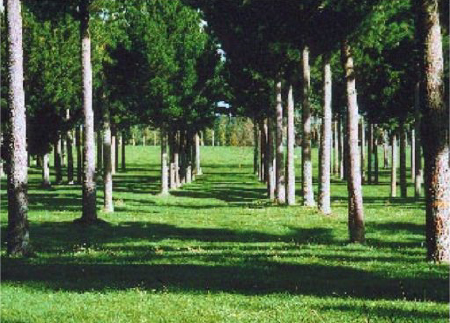
Agro–Indigenous Forestry: The production of mature amenity trees is just one agroforestry opportunity for maximising the opportunity for indigenous species. Tōtara, for its hardiness, and pūriri, for its amenity tree marketability, might make an entirely economic combination, particularly in proximity of the Auckland market. image New Zealand Farm Forestry Association
Agro–forestry indigenous
Although the convention wisdom strongly favours poplar, a myriad of indigenous agroforestry combinations are worthy of trial. For example, on terrain than can be accessed by tree spade, mature amenity trees could be a more lucrative option. As the singularly fastest growing indigenous tree species, the lollipop form that pūriri readily takes makes it attractive to landscapers—a potentially lucrative side business in the Auckland region, it might be presumed. Farther north, where distance from the main mature amenity tree market would work against it, tōtara has the particular advantage of coping well with exposure, although the regimes required to achieve columnar form could take time to fully develop.
Indigenous hamlet
Land of low agricultural value could potentially be more effectively developed for residential purposes under new hamlet rules, rather than the more common restoration subdivision rules in place in most jurisdictions, which tend to lower agricultural productivity, produce relatively fragmented plantings, and require considerable road construction. Again, a mix of restoration and production planting could maximise the area converted to indigenous species.
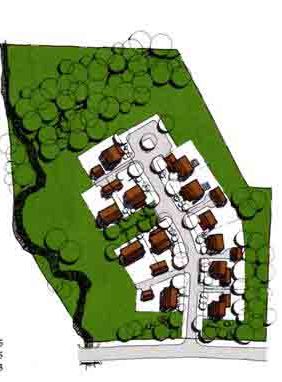
That’s Your Lot: Despite the concept being toiled over for decades, the sum total of rural hamlet opportunities in the 6000 square kilometre Auckland region is one. Hamlet subdivision has the potential to protect much land from the unproductive fragmentation that results from the current rural subdivision rules. image Terra Nova Planning
Forestry-style forestry
As mentioned earlier, if the opportunity for establishing indigenous plants is not to be lost to the competing imperatives to maximise food production, carbon drawdown, and to substitute timber and other natural fibre for the high-carbon products, the economics must be made compelling. Literally at the beginning of planting projects, the comparatively much higher cost of indigenous plants than exotic seedlings is a major impediment. However, a belated revolution is well underway. Landcorp Farming this year, for the first time, has exclusively specified plants raised forestry-style in open-ground beds, in its order with Taupō Native Plant Nursery. This development is the happy result of an initiative that spun out of the Mahurangi Action Plan, serendipitously coinciding with a strategic decision by the nursery to greatly expand its open-ground production capability.
The first ever scientific comparison of open-ground and container –raised indigenous plants was a Mahurangi initiative—a $135 000 Sustainable Farming Fund project, supported by the former Rodney District Council. Initially 5580 plants of six revegetation species and of three stock types were established, on three trial sites. After being established for one year, the plants were measured for survival, vigour, canopy spread and height. Of the three stock types trialled, open-ground, PB3-sized planter bag or pots, and Hillson-sized root trainers, the open-ground and PB3-sized plants were comparable, but the root trainer plants performed poorly. But adjusted for cost and survival, the open-ground plants at a nominal $2.50—one dollar cheaper than the large container plants—the open-ground plants were shown to be more cost effective in terms of canopy spread.
Meantime, word had spread of the Mahurangi trials and in 2008 the project’s principals prepared a funding application on behalf of Tāne’s Tree Trust, to the Lake Taupō Protection Trust. This was successful and has allowed trials involving 5000 plants being established, in 2009 and 2010.
This year, a fresh Sustainable Farming Fund project, co-funded by Auckland Council and others, is allowing the Taupō plants to be measured, and those in the Mahurangi trials to be remeasured. Half of the Mahurangi re-measuring has been completed, and although the data is yet to analysed, the impression is that the differences apparent after the first year are largely unchanged. What has changed, however, is the price of the open-ground plants, which Taupō Native Plant Nursery has halved to $0.75 each—the trials also allowing the nursery to better assess the cost of production.
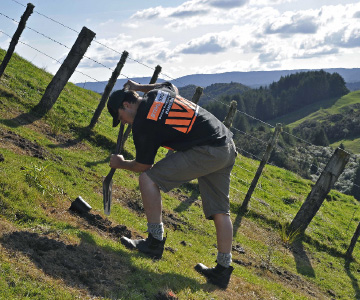
Catching on at Taupō: Building on the success of the Mahurangi open-ground trials, a second major set of trials were established in the Lake Taupō catchment. But while reducing sediment generation is the principal objective in the Mahurangi Harbour catchment, nitrogen enrichment is the chief threat to the iconic Taupō. Here Michael Bergin powers into the planting, with the same energy that, last week, he took 16 000 measurements in four days. image Dr David Bergin
Playing nicely
Research into all aspects of radiata pine have enjoyed consistently high levels of funding, almost since the inception of a forest service, in 1919. Had even a small fraction of that funding been devoted to them, select indigenous species would today be better capable of competing for real estate with exotics. What has been missing so glaringly is the earlier willingness, under the New Zealand Forest Service, to advance exotics and indigenous species together. The work by Jaap van Dorsser in adapting the open-ground nursery methods used for radiata pine to indigenous species, followed radiata pine methods being adapted from those developed the raise eucalypts—which, of course, are indigenous to Australia.
Species that can be grown directly from seed in open-ground beds, such as radiata pine, enjoy are considerable advantage over those that, for reasons of low seed viability or extreme tenderness when emergent—both are common attributes of many species indigenous to Aotearoa. Such species are initially raised in plug trays, which not only increases the danger of root circling but also adds significantly to the cost of production. A development that would appear to have considerable potential to improve the performance of plants grown directly from seed is the Cross Slot seed drill. But rather than trial the possibility with indigenous species, beginning with hardy, high-viability radiata pine seed would be the more pragmatic approach—exotics could provide indigenous with a nice leg-up. Conceivably, once seed supply and viability issues have been addressed, Cross Slot sowing might even be used to directly establish indigenous nurse crops.
The other area whereby exotics and indigenous show promise of being extremely complementary is where radiata pine is used as a nursery or interim crop, and the economic benefit would not necessarily be all one way in favour of indigenous. There is also potential for enhancing the biodiversity within radiata pine forestry, at little additional cost.
The right royal commission
After years of prevarication, the 1913 Royal Commission on Forestry was established, which led directly to Aotearoa becoming a forestry world-leader with the largest planted forests ever established. While the 2013 Royal Commission on Indigenous Forestry would ring a nicely symmetrical centennial bell, it should have occurred in the 1960s when Forest Research Institute director Harry Bunn saw the writing on the wall for logging indigenous forest on crown land, and instructed his head nurseryman, Jaap van Dorsser, to
…learn how to grow the bugger.
The 1913 Royal Commission on Forestry recommendations did consider indigenous forestry, but not favourably, as Dr David Bergin acknowledges in his Growth and Management of Planted and Naturally Regenerating Stands of Podocarpus Tōtara D.Don:
Thank you to Gerard Horgan for gleefully pointing out the 1913 Royal Commission on Forestry report which highlighted ‘the utter absurdity of suggesting such a tree as the tōtara for afforestation purposes’.
Fortunately, as Dr Bergin hoped it might, his doctorate thesis has ‘gone some way to supporting an alternative view of the management of planted tōtara for timber production’, as has his subsequent work with the Northland Tōtara Working Group, which has successfully measured the acceleration of growth that occurs when regenerating stands of tōtara are thinned and limbed.
And while indigenous forestry proponents might consider that late is better than never, the terms of reference would now clearly have to be much broader, to be in fact a royal commission on the global warming and population implications for land use—or try 2013 Royal Commission on Global Warming, Population and Land Use. But aside from its prodigious scope, such a commission could not afford to repeat of the high-handedness of the Royal Commission on Auckland Governance, which abjectly failed to win hearts and minds, including, critically, those within of the government of the day. A fine exemplar for future royal commissioners is the Ruataniwha Water Storage Project, where stakeholders were not so much consulted, but brought in, if not on the ground floor, then certainly while concepts were still entirely malleable, to democratically devise a solution to Hawke’s Bay’s water sustainability and allocation issues.
Out of the 1913 Royal Commission on Forestry came the New Zealand Forest Service, but an indigenous forestry service is not what is being advocated here, rather something much more ambitious. For example, the envisaged ministry might be responsible, in consultation with local territorial authorities, for drafting all rural land use rules, which then become the palette from which the individual local authorities would paint their district plans, whilst adhering to national land use guidelines.
With the epic global changes occurring to climate, in population, and to energy supply, and an all‑of‑the‑above mobilisation inevitable, albeit belated, it is incumbent on those determined to see large‑scale indigenous forestry kick-started to consider both the big picture mechanism’s, such as a royal commission on land use, and the specific, such as the forestry-style open-ground nursery production methods.
Ninety-nine years since the last, it is now well past time for the next royal commission on forestry—by necessity, it must now be on global warming, population and land use.
